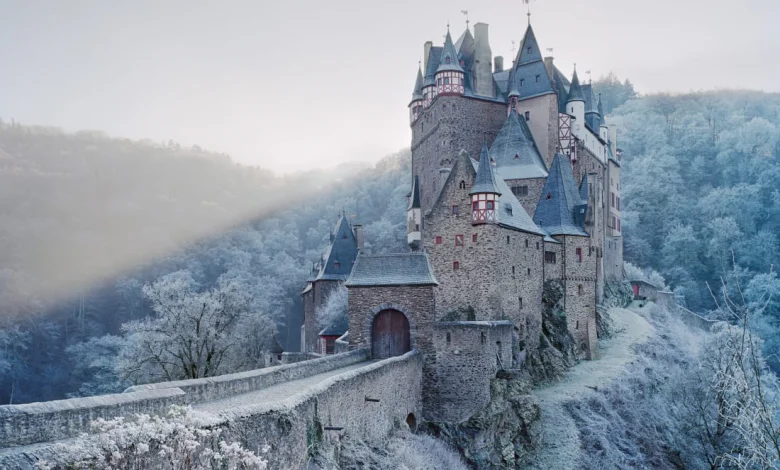For centuries, medieval castles — hulking, isolated triumphs of masonry — have held a special place in the Western imagination, evoking at once a sense of history, fantasy, war and romance. They are the perennial backdrops for period dramas and children’s books, travel brochures and fashion spreads.
But in his latest book, “Stone Age: Ancient Castles of Europe,” writer and photographer Frédéric Chaubin set out to disrupt the familiar stereotypes, using prose and photography to link the medieval with the Modernist.
“Instead of just considering them as historical remains, I was much more interested in building a link between this very primitive architecture and the basics and principles of Modernism, which were more or less set up at the beginning of the 20th century through theoretical works by Adolf Loos or Le Corbusier,” he explained in a phone interview, referring to the influential theorists and architects who lobbied against ornamentation and venerated clean shapes.”(The principle) that form follows function is perfectly expressed in this very, very primitive architecture.”

When castles first emerged in the 10th century as an alternative to wooden structures, they were envisaged as fortified dwellings for the ruling class. Protection trumped decoration: Towers were built high to safeguard inhabitants from outside threats, moats were defenses rather than water features and designs were adapted to fit the changing rules of war or the domestic needs of castle residents.
“Stone Age” is Chaubin’s second book, following 2011’s “CCCP: Cosmic Communist Constructions Photographed,” a stylish tome that presented seven years’ worth of photography and research into the architecture of the Soviet Union. For his new book, however, he armed himself with a traditional large-format view camera and travelled to the United Kingdom, France, Spain, Germany, the Baltics and beyond, photographing more than 200 castles built between the 10th and 15th centuries.

When making his final selection, Chaubin prioritized the impressiveness of a castle’s location and its architectural simplicity — in keeping with his overarching theme — rather than its historical significance. “It’s about the (context) much more than about the buildings themselves,” he said. “The most interesting ones are the ones that are really isolated; you have the feeling that you discovered them.”
An evolving role
Typically, Chaubin shot the castles upon approach, capturing their majesty as they first emerged into view — the Grimburg Castle in Germany, for instance, appears as a darkened silhouette against frost-covered terrain, while a placid lake separates the photographer from Scotland’s Castle Stalker. Chaubin hoped to convey “the specific moments when you first see the building.”
“I quite often feature the castle at a distance because usually you discover buildings at a distance,” he explained. “I’m inviting people to travel with me.”

The photographer was particularly taken with the ruined sandstone Château de Quéribus in the south of France, or Manqueospese, in Avila, Spain, which was constructed from local granite — castles that convey a natural connection to their surroundings and “seem to be getting out of the ground,” as Chaubin put it.
The book is divided into thematic chapters addressing the origins and evolution of castles, the geopolitical context of their development and, later, their abandonment. While the structures Chaubin spotlights share similarities in terms of material and basic forms, he found organizing them chronologically a challenge.

“It’s extremely difficult to connect them with a specific period because, with the European medieval castles I was photographing, (the construction started) around the 10th century but then they went through transformations for centuries and centuries,” he said.
The 13th-century castles he photographed in Wales, for example, were modified over time in keeping with the evolution of weaponry and war strategies; Moorish castles on the Iberian Peninsula were radically redesigned by the Catholics who later took them over. As the Renaissance approached, and the near-constant threat of invasion disappeared, decorative elements and large windows were often introduced to facilitate a castle’s transition from fortress to palace.

“From the 15th century onwards, they had no reason to be (a defensive structure), so the castles were turned into mansions or palaces, or left to decay,” Chaubin explained.
Dividing the castles by location seemed equally futile, given that Europe’s borders were in constant flux during the centuries covered in the book. The abundance of invasions (which explains the trail of Crusades-era Norman castles between modern-day England and the Middle East) and intermarriage between monarchies also meant that architectural styles were widely exported and adapted to incorporate local vernaculars.
But, ultimately, this lack of visual coherence was a source of fascination rather than frustration for Chaubin.
“I was much more impressed by the array of differences (than the similarities),” he said. “The very large typology of those castles made the subject more difficult to deal with, but at the same time, more interesting.”
“Stone Age: Ancient Castles of Europe,” published by Taschen, is available now.

